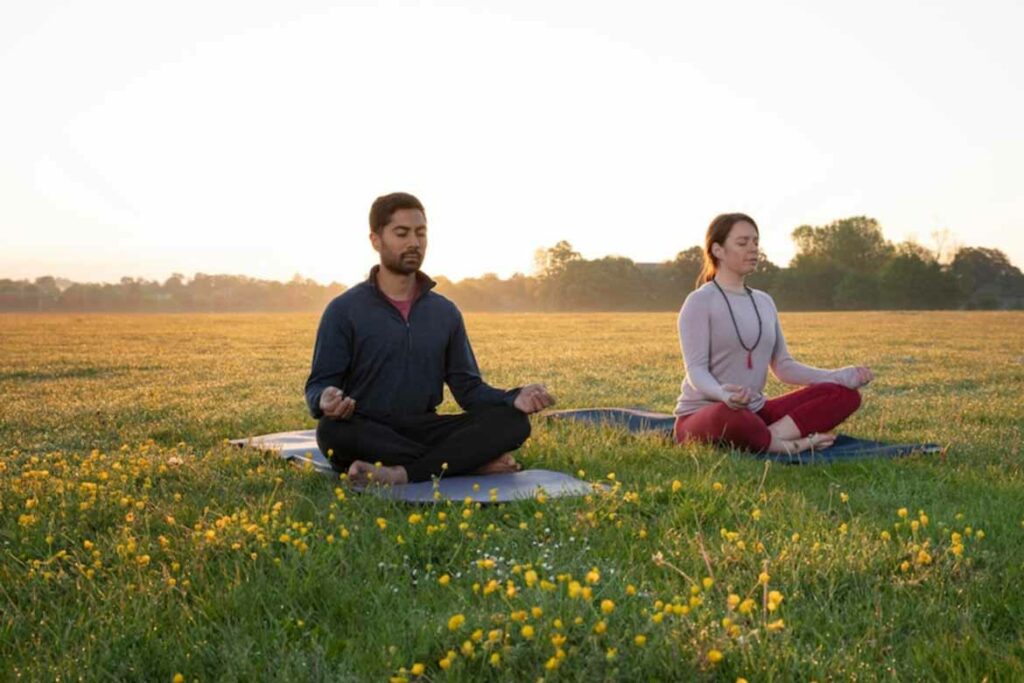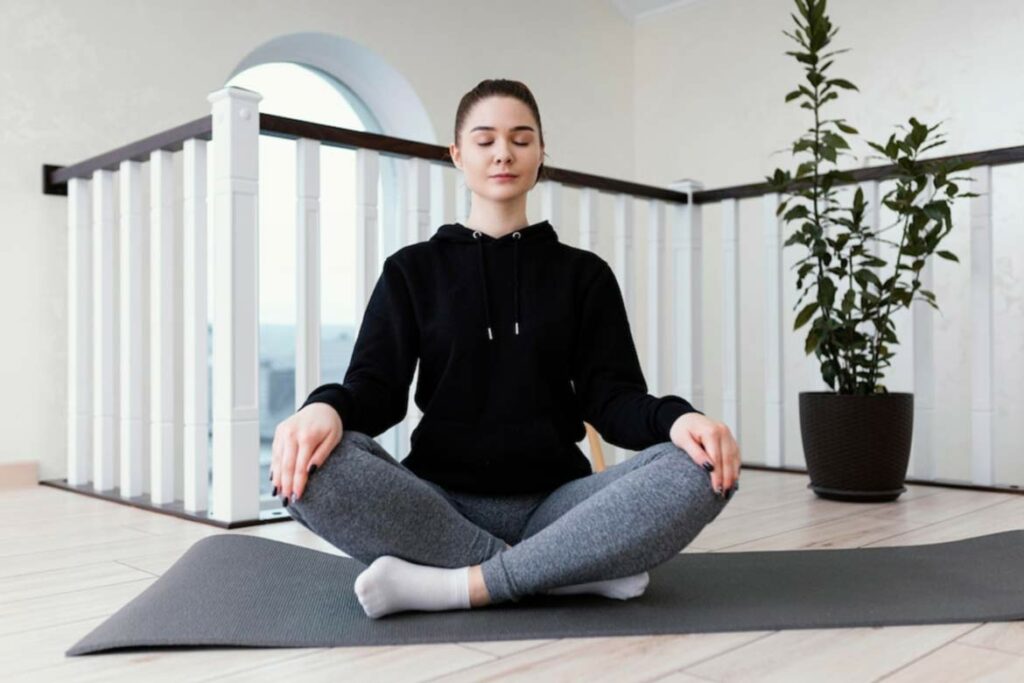Meditation and Yoga have gained so much popularity in the last few decades. You must be aware of the advantages of meditation. But with so many meditation practices available, beginning might be intimidating. Different types of meditation have distinct benefits. Today, in this article, we will discuss about Body Scan meditation, and how to do it. And its benefits.
What is Body Scan meditation?
Body scan meditation is a meditation technique that includes mindfully scanning the body for discomfort, stress, or anything unusual.
Gaining a deeper understanding of your body’s sensations can make you feel more a part of yourself and give you a better understanding of the possible reasons for unpleasant emotions. This understanding can enhance both physical and emotional health.
What are the advantages of body scan meditation?

Read more: Relaxed body relaxes mind: Yoga Asanas that you must do before going to bed
There is proof that meditation can improve both physical and emotional health in a variety of ways, including: Better sleep, Anxiety and stress management , Enhanced self-awareness, Boosted self-compassion, Reduced pain, Reduced cravings, etc.
Some of the most thoroughly studied advantages of meditation are:
Better sleep
It is suggested that mindfulness meditation may help reduce the effects of certain types of sleep problems and improve sleep quality.
Many people struggle to get a good night’s sleep when feeling anxious or stressed. Because meditation can help you relax, clear your mind of disturbing thoughts, and feel calmer overall, practicing meditation regularly can reduce anxiety and keep you awake.
Managing stress and anxiety
Research supports meditation as a helpful way to reduce anxiety and stress.
The potential for mindfulness meditation to lessen symptoms of general anxiety has been suggested by research from 2013Trusted Source. The ability to manage stress may benefit from mindfulness-based stress reduction techniques, according to the study.
Allaying pain
If you’ve ever felt significant pain, it can be hard for you to think about anything else. This is the daily experience of many people living with chronic pain. Naturally, this type of pain can have a significant negative impact on your life.
Meditation doesn’t necessarily end the pain. But the results of meditation, such as increasing awareness of your body and emotional state, can help change the way you think about this pain. Increased awareness and acceptance of pain can lead to an improved outlook.
These benefits may have a longer-lasting impact than standard chronic pain care. Meditation experts recommend body scan meditation as the most helpful type of meditation for pain relief.
How to perform Body-scan meditation?

You can think of the body scan meditation as a mental X-ray that moves slowly through your body. Here’s how to try it out:
- Make you comfortable- Start by making yourself comfortable. Lie down or sit in a position that allows you to easily straighten your limbs.
- Try to focus-Close your eyes and start focusing on your breathing. Notice how your breath feels in and out of your lungs as you inhale and exhale.
- Choose an area of the body- Start where you want – left arm, left foot, right hand, right foot, top of your head. Focus on this point while continuing to breathe slowly and deeply.
- Keep your complete focus here- Expand your awareness of pain, stress, discomfort, or anything out of the ordinary.
- Go slowly-Take 20 seconds to 1 minute to observe these sensations.
- Embrace it- If you start to feel pain and discomfort, acknowledge and sit with whatever emotion this sensation evokes. Accept them without criticism. For example, if you feel frustrated and angry, don’t judge yourself for those feelings. Notice them and let them pass.
- Breathe-Continue calm breathing, imagining that the pain and tension will lessen with each breath.
- Exit-Slowly release your mental awareness on that particular part of your body and redirect it to your next area of interest. Some people find it helpful to imagine that they are releasing one part of their body as they exhale and moving on to the next as they inhale.
- Keep a tab on derailment- As you continue to scan your body, notice when your thoughts begin to drift away. This will probably happen more than once, so don’t worry. You didn’t fail and you can easily get your idea on the right track. Just gently bring your awareness back to where you left off.
- Visualize and breathe- After scanning the body parts, allow consciousness to travel through the body. Visualize it as a mold-filling liquid. Continue to inhale and exhale slowly as you sit with full-body awareness for a few seconds.
- Ending– Slowly release your focus and draw your attention back to your surroundings.
Tips for long-term benefits from body scan meditation

Read more: Here’s how meditation helps in controlling blood sugar
Inculcate this in your daily routine
You can notice an immediate improvement. It can, however, also raise your awareness around discomfort, making it seem worse. This may cause you to stop meditating altogether, but try doing it a few more times to see if things improve.
Many people don’t like meditation or don’t notice any benefits the first few times they try it. But experts say you should still meditate regularly, even if you don’t like it.
If it helps, you can consider meditation as an exercise for your brain. You probably don’t want to sweat all the time, especially if you’ve had a hard day. But once you’re there, your training usually gets easier, doesn’t it?
When you’re done exercising, you may even feel pretty good, and sticking to an exercise routine often makes things easier over time.
Do not try to achieve perfection in one go
When it comes to meditation, there is no one “right” approach. Ultimately, the best type of meditation is the one that works for you.
Many people find it more helpful to meditate at the same time each day and in the same place. It can help you get into the habit but don’t worry if you have to cut it short sometimes.
Meditating for 15 minutes or even 5 minutes is better than not meditating at all. You’ll probably get distracted, and that’s okay. Instead of giving yourself a hard time, just encourage yourself to keep trying. Remember that you can meditate anywhere. Meditation at home may be easier, but you can practice it anywhere. Tired or stressed at work? Pause for 5 minutes for a quick body scan.
Try lying down, standing up, or even practising meditation outside if you have trouble becoming comfortable in a classic meditation position, such as sitting with your legs crossed.
Don’t attach any specific goals to mediation
You probably meditate regularly for a purpose. You might try to increase your sleep, learn to relax better or lessen your stress.
However, if you go into it with clear objectives, you could feel so committed to achieving them that you find it difficult to pay attention to your physical sensations. You could become more stressed than when you started if you begin to feel like meditation isn’t helping. Start with a single, straightforward objective, such as becoming more aware of what your body is trying to tell you.
